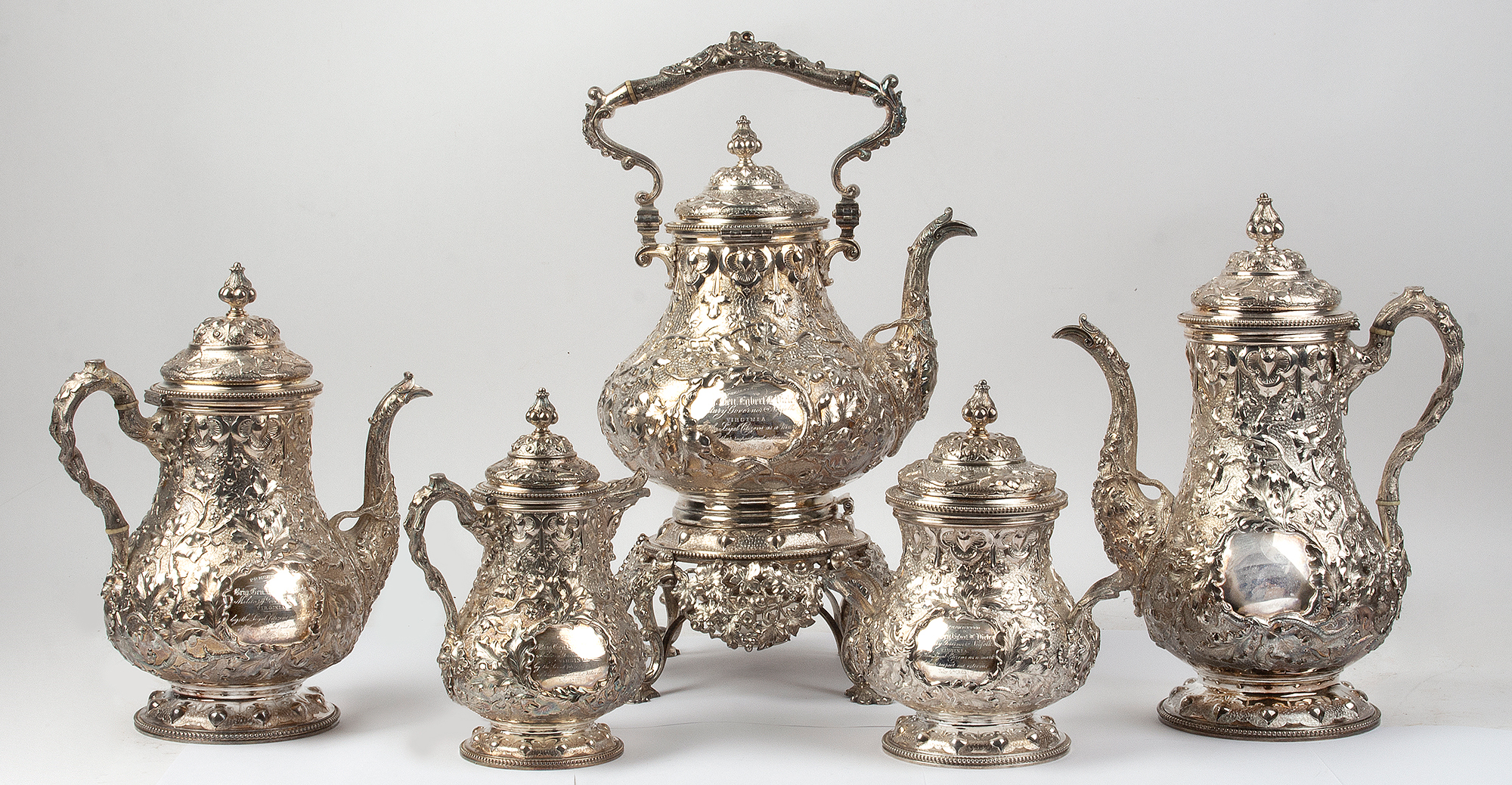



PRESENTED TO Brig. Gen. Egbert L. Vile / Military Governor of Norfolk VIRGINIA / by the Loyal Citizens as a Mark / of their respect and esteem / July 4th 1863
TIFFANY & Co. G 8576 G
ENGLISH STERLING
925-1000
6
550 BROADWAY. N -Y
William Gale for Tiffany & Co. Five Piece Sterling Presentation Tea and Coffee Service, c. 1863, comprising baluster form coffeepot, teapot, kettle on stand with burner, covered sugar, and lidded milk jug, all chased and embossed all over with dense ivy vines on stippled ground, with crabstock handles, beaded rims, each with two roundel reserves to sides of body, one engraved with presentation inscription dated 1863.
The mark is struck "G" twice [centering the pattern number] for William Gale who was one of the great New York City silversmiths that created silver retailed by Tiffany [under their trademark] before they fabricated their own.
It is intriguing to imagine that then Brigadier General Viele's thoughts must have been with his colleagues, and former West Point alumni, while he was receiving this tea and coffee service from the citizens of Norfolk on July 4, 1863. That very day is considered the most pivotal single day in the history of the Civil War, with the Confederacy suffering two of its worst defeats. On July 4, 1863, not only did a badly defeated Lee retreat from Gettysburg after three bloody days of battle, but General Pemberton surrendered to General Grant at the fall of Vicksburg. The South never fully rallied from these two massive defeats.
Civil War Union Brigadier General, US Congressman. He graduated from the United States Military Academy at West Point, New York, in 1847, served in the Mexican War and on the Western frontier before resigning in 1853. Becoming a civil engineer, he supervised the creation of New York City, New York's Central Park in Manhattan, and Prospect Park in Brooklyn. Returning to the Army after the outbreak of the Civil War, he was promoted to Brigadier General, US Volunteer. In April 1862 he commanded the forces and reduction of Fort Pulaski on the Savannah River in Georgia, and after the capture of Norfolk, Virginia, in May 1862, he served there as military governor until October 1863. He resigned from the Army on October 20, 1863, returning to his civilian engineer profession. His "Topographical Atlas of the City of New York City", published in 1876, is still used by New York City engineers. He was elected as a Democrat to represent New York's 13th Congressional District in the United States House of Representatives, serving from 1885 to 1887. Interestingly he had a fear of being buried alive and had a buzzer installed in his mausoleum which if pressed by him would alert someone in the cemetery office to come and let him out. Interred in the mausoleum after he passed away in 1902, after twenty years the buzzer wire was finally cut.
Measurement: Coffeepot ht. 12 3/8 in., approx. 175 troy oz.
Condition: Very good condition displays well; some dents repaired by Tiffany & Co. c. 1980. Coffeepot with slight dent to finial. Kettle missing one pin attaching it to stand; burner unmarked and lacking lid; trivial light usage wear.
$14,500
SKU: 925-56
For More Information, Please Contact David Hillier at 978-597-8084 or email drh@aaawt.com.
Please click on images to expand.